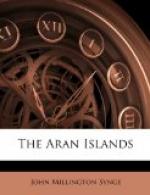On the low sheets of rock to the east I can see a number of red and grey figures hurrying about their work. The continual passing in this island between the misery of last night and the splendor of to-day, seems to create an affinity between the moods of these people and the moods of varying rapture and dismay that are frequent in artists, and in certain forms of alienation. Yet it is only in the intonation of a few sentences or some old fragment of melody that I catch the real spirit of the island, for in general the men sit together and talk with endless iteration of the tides and fish, and of the price of kelp in Connemara.
After Mass this morning an old woman was buried. She lived in the cottage next mine, and more than once before noon I heard a faint echo of-the keen. I did not go to the wake for fear my presence might jar upon the mourners, but all last evening I could hear the strokes of a hammer in the yard, where, in the middle of a little crowd of idlers, the next of kin laboured slowly at the coffin. To-day, before the hour for the funeral, poteen was served to a number of men who stood about upon the road, and a portion was brought to me in my room. Then the coffin was carried out sewn loosely in sailcloth, and held near the ground by three cross-poles lashed upon the top. As we moved down to the low eastern portion of the island, nearly all the men, and all the oldest women, wearing petticoats over their heads, came out and joined in the procession.
While the grave was being opened the women sat down among the flat tombstones, bordered with a pale fringe of early bracken, and began the wild keen, or crying for the dead. Each old woman, as she took her turn in the leading recitative, seemed possessed for the moment with a profound ecstasy of grief, swaying to and fro, and bending her forehead to the stone before her, while she called out to the dead with a perpetually recurring chant of sobs.
All round the graveyard other wrinkled women, looking out from under the deep red petticoats that cloaked them, rocked themselves with the same rhythm, and intoned the inarticulate chant that is sustained by all as an accompaniment.
The morning had been beautifully fine, but as they lowered the coffin into the grave, thunder rumbled overhead and hailstones hissed among the bracken.
In Inishmaan one is forced to believe in a sympathy between man and nature, and at this moment when the thunder sounded a death-peal of extraordinary grandeur above the voices of the women, I could see the faces near me stiff and drawn with emotion.
When the coffin was in the grave, and the thunder had rolled away across the hills of Clare, the keen broke out again more passionately than before.
This grief of the keen is no personal complaint for the death of one woman over eighty years, but seems to contain the whole passionate rage that lurks somewhere in every native of the island. In this cry of pain the inner consciousness of the people seems to lay itself bare for an instant, and to reveal the mood of beings who feel their isolation in the face of a universe that wars on them with winds and seas. They are usually silent, but in the presence of death all outward show of indifference or patience is forgotten, and they shriek with pitiable despair before the horror of the fate to which they are all doomed.




